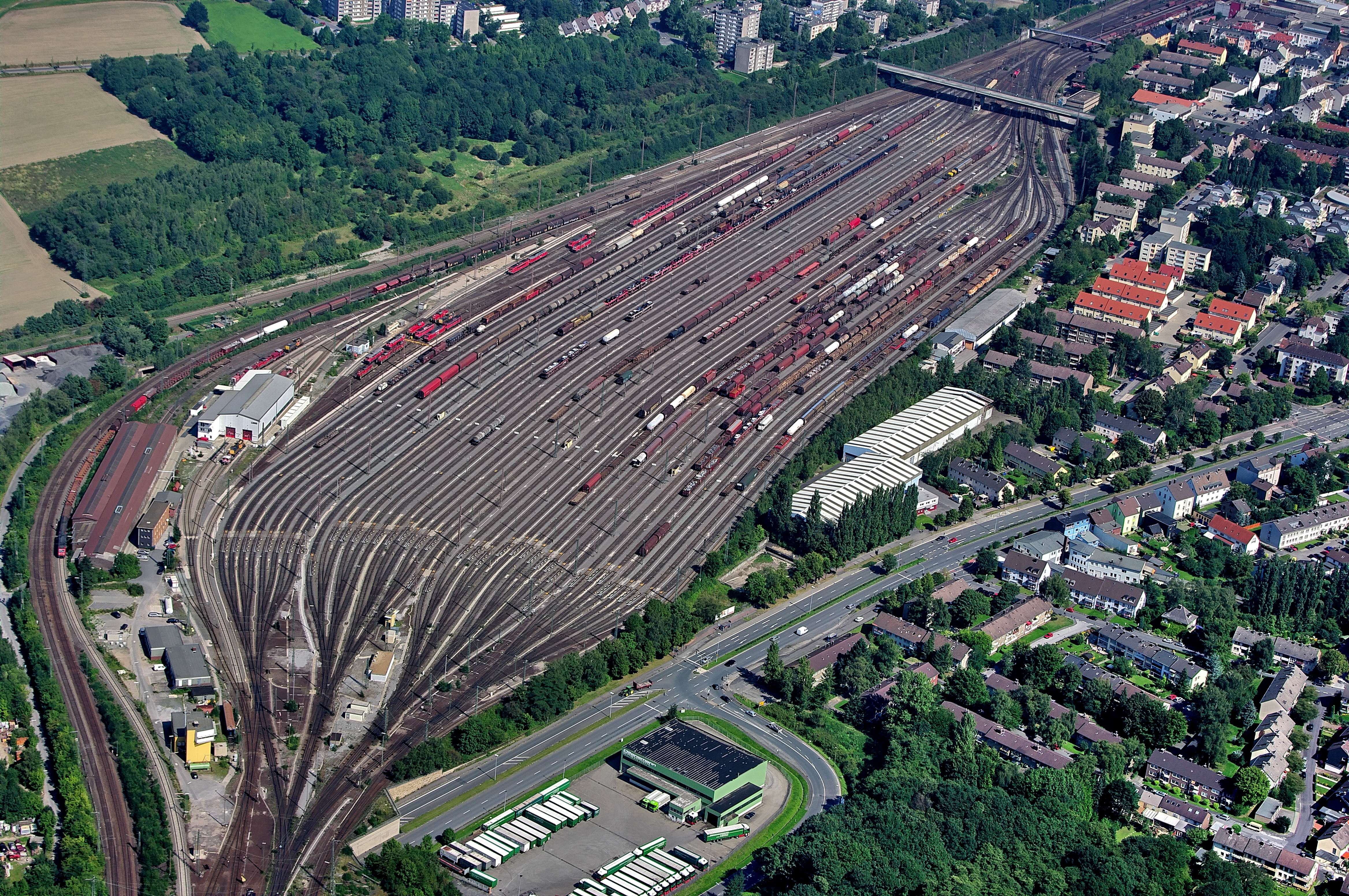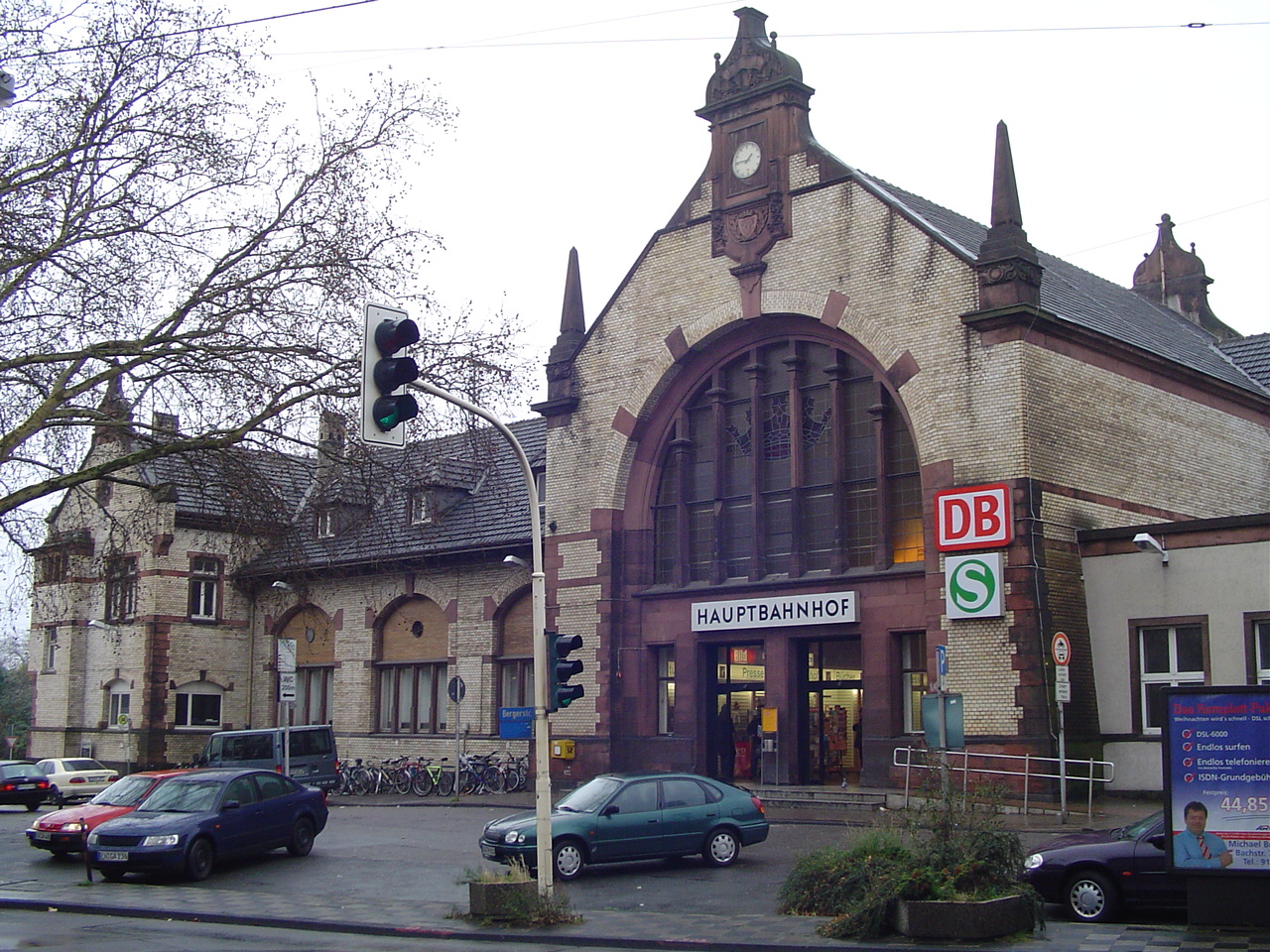|
Hagen-Vorhalle Station
Hagen-Vorhalle station is a large marshalling yard of national importance and a small passenger station for local services in the Hagen district of Vorhalle in the German state of North Rhine-Westphalia. It was opened in its present form in 1910 in and is one of the nine major marshalling yards in Germany and a key element of the ''200X'' program to upgrade Germany's freight infrastructure initiated in 2006 by the former ''Railion Deutschland AG'' (now DB Schenker Rail). The station is located on the Ruhr Valley Railway and the Elberfeld–Dortmund line. The station was opened on the 9 March 1849 as ''Herdecke'' station and successively renamed as ''Herdecke Süd'', ''Herdecke-Vorhalle'' and ''Vorhalle''. It was renamed as ''Hagen-Vorhalle'' in the early 1950s. Marshalling yard The yard has eleven arrival tracks, two hump tracks and 40 classification tracks up to 920 m long. The freight wagons or sets of wagons are run over the hump and then retarded by a series of automati ... [...More Info...] [...Related Items...] OR: [Wikipedia] [Google] [Baidu] |
Hagen
Hagen () is the Largest cities in Germany, 41st-largest List of cities and towns in Germany, city in Germany. The municipality is located in the States of Germany, state of North Rhine-Westphalia. It is located on the south eastern edge of the Ruhr area, 15 km south of Dortmund, where the rivers Lenne and Volme (met by the river Ennepe) meet the river Ruhr (river), Ruhr. As of 31 December 2010, the population was 188,529. The city is home to the FernUniversität Hagen, which is the only state-funded distance education university in Germany. Counting more than 67,000 students (March 2010), it is the largest university in Germany. History Hagen was first mentioned around the year 1200, and is presumed to have been the name of a farm at the confluence of the Volme and the Ennepe rivers. After the conquest of in 1324, Hagen passed to the County of Mark. In 1614 it was awarded to the Margraviate of Brandenburg, according to the Treaty of Xanten. In 1701 it became part of the K ... [...More Info...] [...Related Items...] OR: [Wikipedia] [Google] [Baidu] |
Deutsche Bahn
The (; abbreviated as DB or DB AG) is the national railway company of Germany. Headquartered in the Bahntower in Berlin, it is a joint-stock company ( AG). The Federal Republic of Germany is its single shareholder. describes itself as the second-largest transport company in the world, after the German postal and logistics company / DHL, and is the largest railway operator and infrastructure owner in Europe. Deutsche Bahn was the largest railway company in the world by revenue in 2015; in 2019, DB Passenger transport companies carried around 4.8 billion passengers, and DB logistics companies transported approximately 232 million tons of goods in rail freight transport. The group is divided into several companies, including ''DB Fernverkehr'' (long-distance passenger), '' DB Regio'' (local passenger services) and ''DB Cargo'' (rail freight). The Group subsidiary ''DB Netz'' also operates large parts of the German railway infrastructure, making it the largest rail network in ... [...More Info...] [...Related Items...] OR: [Wikipedia] [Google] [Baidu] |
Buildings And Structures In Hagen
A building, or edifice, is an enclosed structure with a roof and walls standing more or less permanently in one place, such as a house or factory (although there's also portable buildings). Buildings come in a variety of sizes, shapes, and functions, and have been adapted throughout history for a wide number of factors, from building materials available, to weather conditions, land prices, ground conditions, specific uses, prestige, and aesthetic reasons. To better understand the term ''building'' compare the list of nonbuilding structures. Buildings serve several societal needs – primarily as shelter from weather, security, living space, privacy, to store belongings, and to comfortably live and work. A building as a shelter represents a physical division of the human habitat (a place of comfort and safety) and the ''outside'' (a place that at times may be harsh and harmful). Ever since the first cave paintings, buildings have also become objects or canvasses of much artis ... [...More Info...] [...Related Items...] OR: [Wikipedia] [Google] [Baidu] |
Rhine-Ruhr S-Bahn Stations
The Rhine-Ruhr metropolitan region (german: Metropolregion Rhein-Ruhr) is the largest metropolitan region in Germany, with over ten million inhabitants. A polycentric conurbation with several major urban concentrations, the region covers an area of , entirely within the federal state of North Rhine-Westphalia. The Rhine-Ruhr metropolitan region spreads from the Ruhr area (Dortmund-Essen-Duisburg-Bochum) in the north to the urban areas of the cities of Mönchengladbach, Düsseldorf (the state capital), Wuppertal, Leverkusen, Cologne (the region's largest and Germany's fourth largest city), and Bonn in the south. The location of the Rhine-Ruhr at the heart of the European Blue Banana makes it well connected to other major European cities and metropolitan areas such as the Randstad, the Flemish Diamond and the Frankfurt Rhine Main Region. The metropolitan area is named after the Rhine and Ruhr rivers, which are the region's defining geographical features and historically its ... [...More Info...] [...Related Items...] OR: [Wikipedia] [Google] [Baidu] |
Railway Stations In North Rhine-Westphalia
Rail transport (also known as train transport) is a means of transport that transfers passengers and goods on wheeled vehicles running on rails, which are incorporated in tracks. In contrast to road transport, where the vehicles run on a prepared flat surface, rail vehicles (rolling stock) are directionally guided by the tracks on which they run. Tracks usually consist of steel rails, installed on sleepers (ties) set in ballast, on which the rolling stock, usually fitted with metal wheels, moves. Other variations are also possible, such as "slab track", in which the rails are fastened to a concrete foundation resting on a prepared subsurface. Rolling stock in a rail transport system generally encounters lower frictional resistance than rubber-tyred road vehicles, so passenger and freight cars (carriages and wagons) can be coupled into longer trains. The operation is carried out by a railway company, providing transport between train stations or freight customer faciliti ... [...More Info...] [...Related Items...] OR: [Wikipedia] [Google] [Baidu] |
Dortmund Hauptbahnhof
Dortmund Hauptbahnhof is the main railway station in Dortmund, North Rhine-Westphalia, Germany. The station's origins lie in a joint station of the Köln-Mindener Eisenbahn and Bergisch-Märkische Eisenbahn which was built north of the city centre in 1847. That station was replaced by a new station, erected in 1910 at the current site. It featured raised embankments to allow a better flow of traffic. At the time of its opening, it was one of the largest stations in Germany. It was, however, destroyed in an Allied air raid on 6 October 1944. The main station hall was rebuilt in the year 1952 in a contemporary style. Its stained glass windows feature then-common professions of Dortmund. The station has 190,000 passengers passing through each day. History The original Dortmund station was built north of the city centre by the Cologne-Minden Railway Company (''Cöln-Mindener Eisenbahn-Gesellschaft'', CME) as part of its trunk line and opened on 15 May 1847. Two years later the Berg ... [...More Info...] [...Related Items...] OR: [Wikipedia] [Google] [Baidu] |
Rhine-Ruhr S-Bahn
The Rhine-Ruhr S-Bahn (german: S-Bahn Rhein-Ruhr) is a polycentric and electrically driven S-train network covering the Rhine-Ruhr Metropolitan Region in the German federated state of North Rhine-Westphalia. This includes most of the Ruhr (and cities such as Dortmund, Duisburg and Essen), the Berg cities of Wuppertal and Solingen and parts of the Rhineland (with cities such as Cologne and Düsseldorf). The easternmost city within the S-Bahn Rhine-Ruhr network is Unna, the westernmost city served is Mönchengladbach. The S-Bahn operates in the areas of the Verkehrsverbund Rhein-Ruhr and Verkehrsverbund Rhein-Sieg tariff associations, touching areas of the Aachener Verkehrsverbund (AVV) at Düren and Westfalentarif at Unna. The network was established in 1967 with a line connecting Ratingen Ost to Düsseldorf-Garath. The system consists of 16 lines. Most of them are operated by DB Regio NRW, while line S28 is operated by Regiobahn and S7 by Vias. The S19 will run 24/7 between ... [...More Info...] [...Related Items...] OR: [Wikipedia] [Google] [Baidu] |
S5 (Rhine-Ruhr S-Bahn)
Line S 5 is a S-Bahn line in the Rhine-Ruhr network. It is operated by DB Regio. It runs from via to . There are current plans to expand the line by building five new stations. It is operated between Dortmund and Witten at 30-minute intervals and between Witten and Hagen at 60-minute intervals using Alstom Coradia Continental type 1440.3 and class 422. Line S 5 runs over the Elberfeld–Dortmund railway opened by the Bergisch-Märkische Railway Company The Bergisch-Markisch Railway Company (german: Bergisch-Märkische Eisenbahn-Gesellschaft, BME), also referred to as the Berg-Mark Railway Company or, more rarely, as the Bergisch-Markische Railway Company, was a German railway company that togeth ... on 20 December 1848. S-Bahn services commenced on the whole length of the route on 29 May 1994. References S05 1994 establishments in Germany {{RhineRuhr-SBahn-stub ... [...More Info...] [...Related Items...] OR: [Wikipedia] [Google] [Baidu] |
Hagen Hauptbahnhof
Hagen Hauptbahnhof is a railway station serving the city of Hagen in western Germany. It is an important rail hub for the southeastern Ruhr area, offering regional and long distance connections. The station was opened in 1848 as part of the Bergisch-Märkische Railway Company's Elberfeld–Dortmund line and is one of the few stations in the Ruhr valley to retain its original station hall, which dates back to 1910. History The original Elberfeld–Dortmund trunk line of the Bergisch-Märkische Railway Company was completed in 1848/49 linking Hagen to the rapidly expanding Prussian railway network. This led to Hagen quickly becoming an industrial city based steel and metal production. After the opening of the Ruhr–Sieg railway to Siegen via Altena in 1861 the city also became an important railway junction. The Baroque Revival entrance building, opened on 14 September 1910, was built of brick and partly covered with sandstone. It survived bombing during the Second World War, ... [...More Info...] [...Related Items...] OR: [Wikipedia] [Google] [Baidu] |
Essen Hauptbahnhof
Essen Hauptbahnhof (German for "Essen main station") is a railway station in the city of Essen in western Germany. It is situated south of the old town centre, next to the A 40 motorway. It was opened in 1862 by the Bergisch-Märkische Eisenbahn. However, the station was not the first in Essen: as the station called ''Essen'' (today Essen-Altenessen) on the Köln-Mindener Eisenbahn was opened in 1847. The station suffered extensive damage in World War II and was almost completely rebuilt in the 1950s and 1960s. During the following years, the Essen Stadtbahn and the A 40 were other construction projects affecting the station. Today it is an important hub for local, regional and long-distance services, with all major InterCityExpress and InterCity trains calling at the station as well as RegionalExpress and Rhein-Ruhr S-Bahn services. Trains of all kinds call at the station, from long distance to local services. It used to be one of the Metropolitan stops on the Hamburg to Co ... [...More Info...] [...Related Items...] OR: [Wikipedia] [Google] [Baidu] |








